标签:
Hadoop的MapReduce程序提交到集群环境中运行,出问题时定位非常麻烦,有时需要一遍遍修改代码和打印日志来排查问题,哪怕是比较小的问题。如果数据量很大的话调试起来就相当耗费时间。 而且,Map和Reduce的一些参数是Hadoop框架在运行时传入的,比如Context、InputSplit,这进一步增加了调试的难度。如果有一个良好的单元测试框架能帮助尽早发现、清除bug,那就太好了。
MRUnit是Cloudera公司专为Hadoop MapReduce写的单元测试框架,API非常简洁实用。MRUnit针对不同测试对象使用不同的Driver:
MapDriver:针对单独的Map测试
ReduceDriver:针对单独的Reduce测试
MapReduceDriver:将map和reduce串起来测试
PipelineMapReduceDriver:将多个MapReduce对串志来测试
接下来,小讲就以Temperature程序作为测试案例,说明如何使用MRUnit框架?
为了理解单元测试框架,我们准备了一个 MapReduce程序,这里还是以 Temperature 作为测试案例进行演示,只不过 map 方法中的气象站id(key)是从读入文件名称中提取的,为了便于单元测试,这里我们将 key 设置为常量03103,Temperature 具体代码如下所示。
package com.dajiangtai.hadoop.test;
import java.io.IOException;
import org.apache.hadoop.io.IntWritable;
import org.apache.hadoop.io.LongWritable;
import org.apache.hadoop.io.Text;
import org.apache.hadoop.mapreduce.Mapper;
import org.apache.hadoop.mapreduce.lib.input.FileSplit;
import java.io.IOException;
import org.apache.hadoop.conf.Configuration;
import org.apache.hadoop.conf.Configured;
import org.apache.hadoop.fs.FileSystem;
import org.apache.hadoop.fs.Path;
import org.apache.hadoop.io.IntWritable;
import org.apache.hadoop.io.Text;
import org.apache.hadoop.mapreduce.Job;
import org.apache.hadoop.mapreduce.Mapper;
import org.apache.hadoop.mapreduce.Reducer;
import org.apache.hadoop.mapreduce.lib.input.FileInputFormat;
import org.apache.hadoop.mapreduce.lib.input.FileSplit;
import org.apache.hadoop.mapreduce.lib.output.FileOutputFormat;
import org.apache.hadoop.util.Tool;
import org.apache.hadoop.util.ToolRunner;
/**
* 统计美国每个气象站30年来的平均气温
* 1、编写map()函数
* 2、编写reduce()函数
* 3、编写run()执行方法,负责运行MapReduce作业
* 4、在main()方法中运行程序
*
* @author zhouls
*
*/
//继承Configured类,实现Tool接口
public class Temperature extends Configured implements Tool
{
public static class TemperatureMapper extends Mapper<LongWritable, Text, Text, IntWritable>
{ //输入的key,输入的value,输出的key,输出的value
/**
* @function Mapper 解析气象站数据
* @input key=偏移量 value=气象站数据
* @output key=weatherStationId value=temperature
*/
public void map(LongWritable key, Text value, Context context) throws IOException, InterruptedException
{ //map()函数还提供了context实例,用于键值对的输出
//第一步,我们将每行气象站数据转换为每行的String类型
String line = value.toString(); //每行气象数据
//第二步:提取气温值
int temperature = Integer.parseInt(line.substring(14, 19).trim());//每小时气温值
//需要转换为整形,截取第14位到19位,把中间的空格去掉。
if (temperature != -9999) //过滤无效数据
{
//第三步:提取气象站编号
//获取输入分片
FileSplit fileSplit = (FileSplit) context.getInputSplit();//提取输入分片,并转换类型
//然后通过文件名称提取气象站编号
String weatherStationId = fileSplit.getPath().getName().substring(5, 10);//通过文件名称提取气象站id
//首先通过文件分片fileSplit来获取文件路径,然后再获取文件名字,然后截取第5位到第10位就可以得到气象站 编号
context.write(new Text(weatherStationId), new IntWritable(temperature));
//气象站编号,气温值
}
}
}
public static class TemperatureReducer extends Reducer< Text, IntWritable, Text, IntWritable>
{
private IntWritable result = new IntWritable();
//因为气温是IntWritable类型
public void reduce(Text key, Iterable< IntWritable> values,Context context) throws IOException, InterruptedException
{ //reduce输出的key,key的集合,context的实例
//第一步:统计相同气象站的所有气温
int sum = 0;
int count = 0;
for (IntWritable val : values) //for循环来循环同一个气象站的所有气温值
{//对所有气温值累加
sum += val.get();
count++;
}
result.set(sum / count);
context.write(key, result);
}
}
public int run(String[] args) throws Exception
{
// TODO Auto-generated method stub
//第一步:读取配置文件
Configuration conf = new Configuration();//读取配置文件
//第二步:输出路径存在就先删除
Path mypath = new Path(args[1]);//定义输出路径的Path对象,mypath
FileSystem hdfs = mypath.getFileSystem(conf);//通过路径下的getFileSystem来获得文件系统
if (hdfs.isDirectory(mypath))//如果输出路径存在
{
hdfs.delete(mypath, true);//则就删除
}
//第三步:构建job对象
Job job = new Job(conf, "temperature");//新建一个任务,job名字是tempreature
job.setJarByClass(Temperature.class);// 设置主类
//通过job对象来设置主类Temperature.class
//第四步:指定数据的输入路径和输出路径
FileInputFormat.addInputPath(job, new Path(args[0]));// 输入路径,args[0]
FileOutputFormat.setOutputPath(job, new Path(args[1]));// 输出路径,args[1]
//第五步:指定Mapper和Reducer
job.setMapperClass(TemperatureMapper.class);// Mapper
job.setReducerClass(TemperatureReducer.class);// Reducer
//第六步:设置map函数和reducer函数的输出类型
job.setOutputKeyClass(Text.class);
job.setOutputValueClass(IntWritable.class);
//第七步:提交作业
return job.waitForCompletion(true)?0:1;//提交任务
}
/**
* @function main 方法
* @param args
* @throws Exception
*/
public static void main(String[] args) throws Exception
{
//第一步
String[] args0 =
{
"hdfs://djt002:9000/weather/",
"hdfs://djt002:9000/weather/out"
};
//第二步
int ec = ToolRunner.run(new Configuration(), new Temperature(), args0);
//第一个参数是读取配置文件,第二个参数是主类Temperature,第三个参数是输如路径和输出路径的属组
System.exit(ec);
}
}
1、打开MyEclipse,以美国气象站为例。在Temperature.java里,

改写为
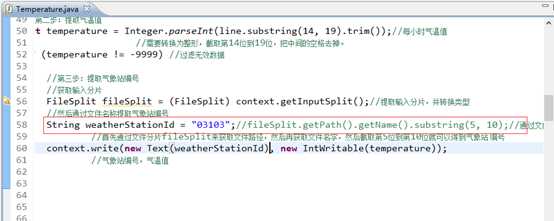
目的是 key 设置为常量03103
因为这个气象站编号需要从文件中截取,不便于测试,所以说,我们将其设置为常量。
2、 在D:\Software\hadoop-2.2.0\下创建extralib文件夹,将下载好的mrunit-hadoop.jar
放在这个目录下。


3、首先需要导入mrunit包,即mrunit-hadoop.jar包
Hadoop -> Bulid Path -> Configure Bulid Path
4、 Java Bulid Path -> Libraries -> Add External JARs … ...
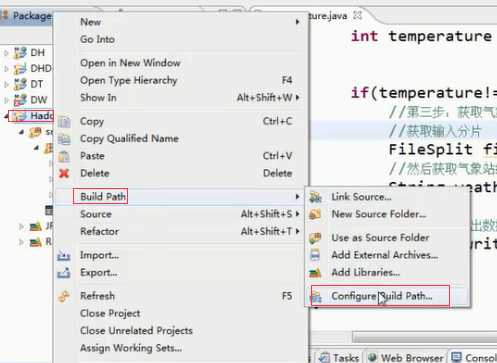

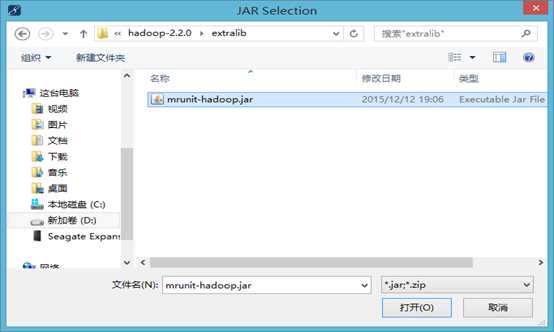

在com.dajiangtai.hadoop.test包下,创建TemperatureMapperTest.java,来对Map进行测试。

6、 编写TemperatureMapperTest.java的代码。 编译,出现以下,则说明无误。
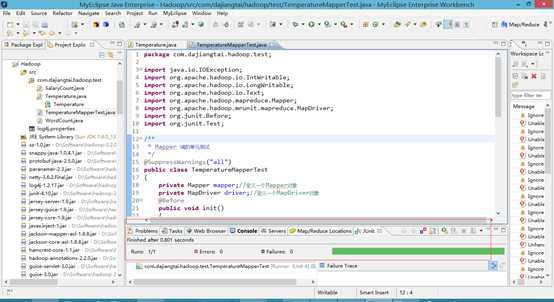
在test()方法中,withInput的key/value参数分别为偏移量和一行气象数据,其类型要与TemperatureMapper的输入类型一致即为LongWritable和Text。 withOutput的key/value参数分别是我们期望输出的new Text("03103")和new IntWritable(200),我们要达到的测试效果就是我们的期望输出结果与 TemperatureMapper 的实际输出结果一致。
测试方法为 test() 方法,左边的对话框里显示"Runs:1/1,Errors:0,Failures:0",说明 Mapper 测试成功了。
在com.dajiangtai.hadoop.test包下,创建TemperatureReduceTest.java,来对Reduce进行测试。
在test()方法中,withInput的key/value参数分别为new Text(key)和List类型的集合values。withOutput 的key/value参数分别是我们所期望输出的new Text(key)和new IntWritable(150),我们要达到的测试效果就是我们的期望输出结果与TemperatureReducer实际输出结果一致。
8 编写TemperatureReduceTest.java的代码。 编译,出现以下,则说明无误。
Reducer 端的单元测试,鼠标放在 TemperatureReduceTest 类上右击,选择 Run As ——> JUnit test,运行结果如下所示。
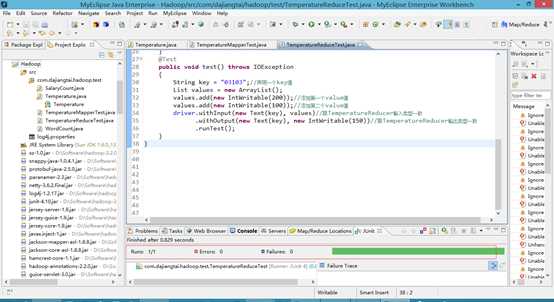
测试方法为 test() 方法,左边的对话框里显示"Runs:1/1,Errors:0,Failures:0",说明 Reducer 测试成功了。
9 MapReduce 单元测试
把 Mapper 和 Reducer 集成起来的测试案例代码如下。
在com.dajiangtai.hadoop.test包下,创建TemperatureTest.java,来进行测试。
在 test() 方法中,withInput添加了两行测试数据line和line2,withOutput 的key/value参数分别为我们期望的输出结果new Text("03103")和new IntWritable(150)。我们要达到的测试效果就是我们期望的输出结果与Temperature实际的输出结果一致。

10 编写TemperatureTest.java的代码。 编译,出现以下,则说明无误。
Reducer 端的单元测试,鼠标放在 TemperatureTest.java类上右击,选择 Run As ——> JUnit test,运行结果如下所示。
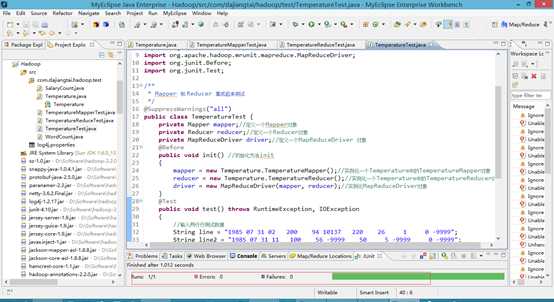
测试方法为 test() 方法,左边的对话框里显示"Runs:1/1,Errors:0,Failures:0",说明 MapReduce 测试成功了。
标签:
原文地址:http://www.cnblogs.com/zlslch/p/5078016.html